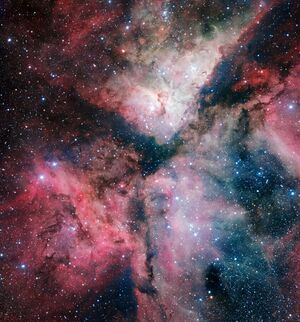Astronomy:QZ Carinae
QZ Carinae (HD 93206) is a multiple star system in the constellation Carina. It is the brightest member of the loose open cluster Collinder 228 and one of the brightest stars in the Carina Nebula. The apparent magnitude is variable from +6.16 to +6.49 with a period of 6 days.
Description
QZ Carinae is approximately 2,300 parsecs (7,500 light-years) from Earth in the Carina Nebula star-forming region.
QZ Carinae is a complex multiple star system made up of at least nine individual stars.[7] Four massive luminous stars dominate the light output of the system.[8] They form a quadruple system of two spectroscopic binaries: Aa (designated A1 and A2) and eclipsing binary Ac (designated B1 and B2).
The A1/A2 and B1/B2 pairs take no more than 25 years to orbit each other, while the A pair completes an orbit around each other every 20.7 days and the B pair every 6.0 days. The system is bright at x-ray wavelengths primarily due to colliding stellar winds in the two close pairs. Pair A1/A2 contributes the bulk of the x-ray luminosity.[4]
Components
QZ Carinae A1 is a blue supergiant of spectral type O9.7I with around 40 times the Sun's mass that has expanded to 22.5 times the Sun's radius. With a surface temperature of 32,000 K, it is around 500,000 times as luminous as the Sun. Its partner A2 is a blue-white main sequence star of spectral type B2V with around 10 times the Sun's mass and 6 times its radius. With a surface temperature of 20,000 K, it is around 5,000 times as luminous as the Sun.
QZ Carinae B1 is a hot blue giant that is expanding and cooling away from the main sequence. It is of spectral type O8III with around 14.1 times the Sun's mass and 26.9 times its radius. With a surface temperature of 32,573 K, it is around 200,000 times as luminous as the Sun. Partner B2 is a hot main sequence star of spectral type O9V with around 28 times the Sun's mass and 8.9 times its radius. With a surface temperature of 32,463 K, it is around 80,000 times as luminous as the Sun. Star B1 is less massive than B2 and is assumed to have undergone significant mass loss or mass transfer to B2.[4] Together, all four stars have a combined mass 94 times that of the Sun.[9]
Variability

Star B is a Beta Lyrae variable eclipsing system. It causes the apparent magnitude of the system to vary regularly every 5.999 days from +6.16 at maximum to +6.49 at the primary minimum and +6.43 at the secondary minimum.[3] It was first noted to be variable in 1972 by observers in Auckland.[9]
References
- ↑ 1.0 1.1 1.2 1.3 1.4 Van Leeuwen, F. (2007). "Validation of the new Hipparcos reduction". Astronomy and Astrophysics 474 (2): 653–664. doi:10.1051/0004-6361:20078357. Bibcode: 2007A&A...474..653V.
- ↑ 2.0 2.1 2.2 Ducati, J. R. (2002). "VizieR Online Data Catalog: Catalogue of Stellar Photometry in Johnson's 11-color system". CDS/ADC Collection of Electronic Catalogues 2237: 0. Bibcode: 2002yCat.2237....0D.
- ↑ 3.0 3.1 3.2 Samus, N. N. et al. (2009). "VizieR Online Data Catalog: General Catalogue of Variable Stars (Samus+ 2007–2013)". VizieR On-line Data Catalog: B/GCVS. Originally Published in: 2009yCat....102025S 1: 02025. Bibcode: 2009yCat....102025S.
- ↑ 4.0 4.1 4.2 4.3 4.4 4.5 4.6 4.7 Parkin, E. R.; Broos, P. S.; Townsley, L. K.; Pittard, J. M. et al. (2011). "X-ray emission from the double-binary OB-star system QZ Car (HD 93206)". The Astrophysical Journal Supplement 194 (1): article id. 8, 11 pp. doi:10.1088/0067-0049/194/1/8. Bibcode: 2011ApJS..194....8P.
- ↑ 5.0 5.1 5.2 5.3 5.4 5.5 5.6 5.7 Brož, M.; Harmanec, P.; Zasche, P.; Catalan-Hurtado, R.; Barlow, B. N.; Frondorf, W.; Wolf, M.; Drechsel, H. et al. (2022). "Towards a consistent model of the hot quadruple system HD 93206 = QZ Carinæ. II. N-body model". Astronomy & Astrophysics 666: A24. doi:10.1051/0004-6361/202243596. Bibcode: 2022A&A...666A..24B.
- ↑ 6.00 6.01 6.02 6.03 6.04 6.05 6.06 6.07 6.08 6.09 6.10 6.11 Rainot, A.; Reggiani, M.; Sana, H.; Bodensteiner, J.; Gomez-Gonzalez, C. A.; Absil, O.; Christiaens, V.; Delorme, P. et al. (2020). "Carina High-contrast Imaging Project for massive Stars (CHIPS). I. Methodology and proof of concept on QZ Car (≡ HD 93206)". Astronomy and Astrophysics 640: A15. doi:10.1051/0004-6361/201936448. Bibcode: 2020A&A...640A..15R.
- ↑ Harmanec, P.; Zasche, P.; Brož, M.; Catalan-Hurtado, R.; Barlow, B. N.; Frondorf, W.; Wolf, M.; Drechsel, H. et al. (2022-04-15). "Towards a consistent model of the hot quadruple system HD 93206 = QZ Carinae - I. Observations and their initial analyses". Astronomy & Astrophysics 666: A23. doi:10.1051/0004-6361/202142108. ISSN 0004-6361. http://arxiv.org/abs/2204.07045.
- ↑ Sanchez-Bermudez, J.; Alberdi, A.; Barba, R.; Bestenlehner, J. M.; Cantalloube, F.; Brandner, W.; Henning, Th; Hummel, C. A. et al. (2017-08-10). "GRAVITY spectro-interferometric study of the massive multiple stellar system HD 93 206 A". The Astrophysical Journal 845 (1): 57. doi:10.3847/1538-4357/aa803d. ISSN 0004-637X. http://arxiv.org/abs/1707.04915.
- ↑ 9.0 9.1 Walker, W. S. G; Marino, B. F. (May 1972). "HD 93206 (CSV 6797) an Eclipsing System Presenting Observational Problems". Information Bulletin on Variable Stars 681 (1): 1. Bibcode: 1972IBVS..681....1W.
- ↑ "MAST: Barbara A. Mikulski Archive for Space Telescopes". Space Telescope Science Institute. https://mast.stsci.edu/portal/Mashup/Clients/Mast/Portal.html.
External links
- Collinder 228 SEDS.org
 |


